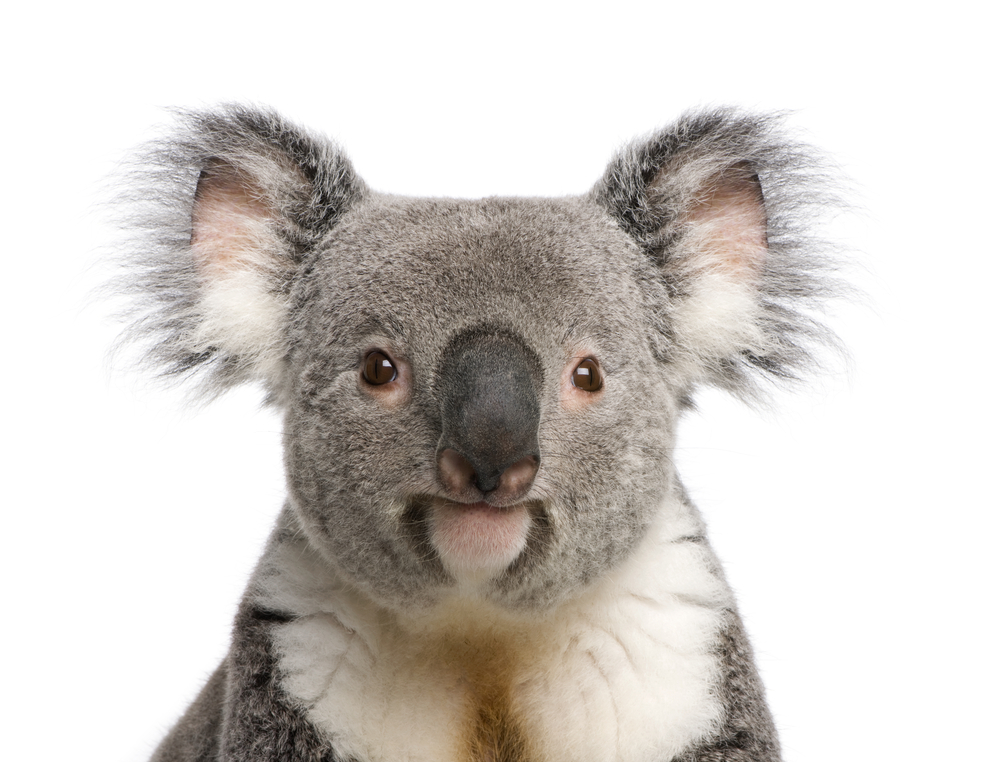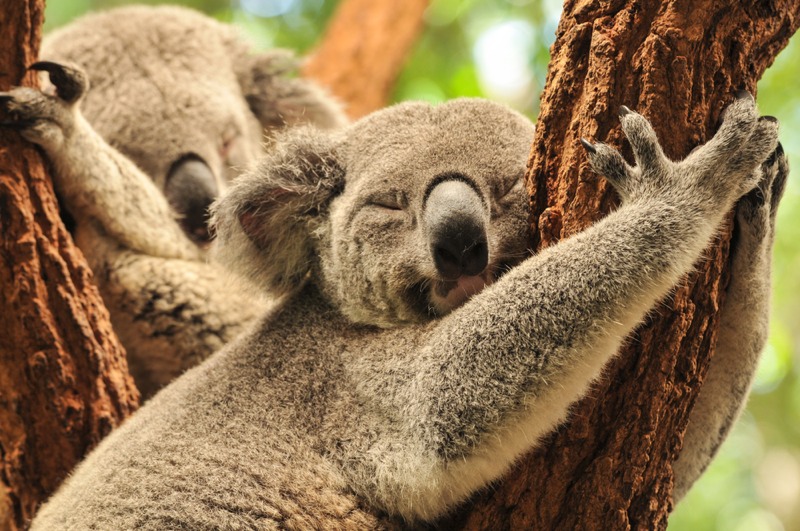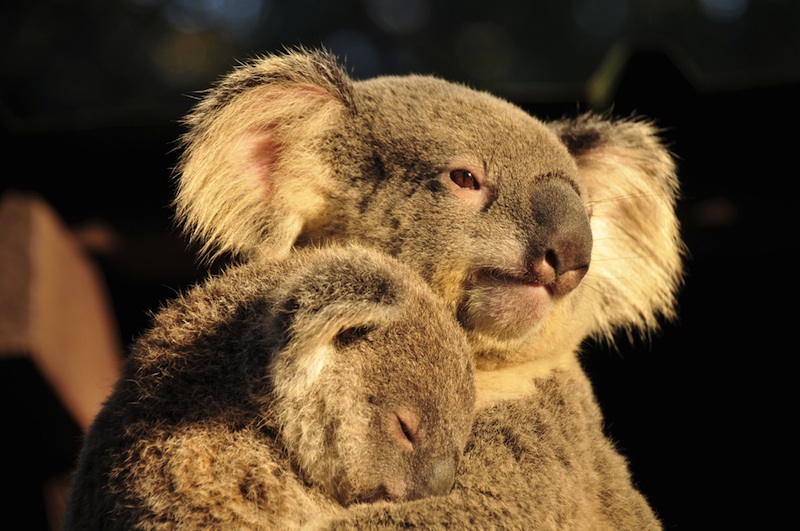Koalas: Facts About Iconic Marsupials

Koalas are tree-hugging marsupials with big, round ears and black oval noses. They are an iconic symbol of Australia, the only place in the world where they are found. Like kangaroos, wombats and opossums, koalas have pouches in which they carry their newborns. Koalas spend most of their time sleeping and eating.
They are often called koala bears, but that is incorrect. Koalas are not bears at all. Both animals are mammals, so they are distantly related. However, koalas are more closely related to kangaroos and wombats. They got the "bear" tagline from English-speaking settlers in the late 18th century because of the koala's bearlike appearance and behavior. The mistake is reflected in the name of the genus, Phascolarctos, which is derived from Greek phaskolos, "pouch," and arktos, "bear."

Size & appearance
Koalas are 2 to 3 feet (60 to 85 centimeters) tall when fully grown. Their weight varies, depending on where the koala lives. Northern koalas weigh around 9 to 19 lbs. (4 to 8.5 kilograms) and southern koalas weigh around 15 to 29 lbs. (7 to 13 kg). Typically, males weigh 50 percent more than females, according to San Diego Zoo.
Koalas range in color from slate gray to reddish brown, according to Sea World. Koala fur isn't as soft as it looks. It is very coarse, like wool. This fur repels water to keep them dry in the rain.
Koalas have large, sharp claws to assist with climbing tree trunks. Their hands and feet are built to curl around tree branches very tightly. Their hands have two opposable thumbs, providing better gripping ability.
Koalas have big, fluffy ears and an excellent sense of hearing. Because they have poor eyesight, koalas generally detect predators by sound, according to the Australian Zoo. They have an even better sense of smell, which helps them select which leaves are best to eat.
Where do koalas live?
Koalas live in southeastern and eastern Australia — in the states of Queensland, new South Wales, South Australia and Victoria — in the eucalyptus forests and woodlands. They live in eucalyptus trees and spend most of their time wedged between forks in the tree's branches. Koalas eat in the trees, sleep in trees and hang out in trees. The only time they leave the trees is to walk to another tree with a better food supply.
Koalas do move around in their chosen tree. When they need to cool down, they find the shadiest spot of the tree to rest. When they are chilled, they move to a sunnier spot.
Koalas spend most of their time sleeping and eating by themselves. The only time they spend with other koalas is during mating and while raising their young.

What do koalas eat?
Koalas eat 3 hours per day, usually during the nighttime, and rest 16 to 18 hours a day, according to the Adelaide Zoo. They sleep so much because they need time and energy to digest their food. It takes a lot of energy to digest the fibrous leaves of the eucalyptus.
Koalas are herbivores who eat only eucalyptus. On average, a koala eats 1 to 1.5 lbs. (454 to 680 grams) of eucalyptus each day, according to the San Diego Zoo. Koalas may spend a lot of their waking time eating, but they are somewhat picky eaters. There are more than 700 eucalyptus species, but koalas will only eat fewer than 50 of those species, according to the Australia Zoo.
Baby koalas
A baby koala is called a joey. A koala carries her joey for a gestation period of 35 days. When it is born, the joey is only around 2 centimeters (.79 inches) long — about the size of a kidney bean, according to the Australian Zoo — and weighs about half a gram (0.017 ounces). Soon after birth, it climbs into its mother's pouch and latches onto one of its mother's teats. The teat swells to keep it firmly in the joey's mouth. The sphincter muscle at the opening of the pouch will keep the joey from falling out, since the joey will reside there as it develops for the next six months. When it gets too big for the pouch, the joey will climb on its mother's back and ride there as they both snack on leaves.

At 12 months, the joey is completely weaned, according to the Adelaide Zoo. Males become sexually mature at 3 to 4 years of age, while females become sexually mature at a much younger age of 2 years. Koalas live 10 to 15 years.
Classification/taxonomy
Koalas are marsupials, which are mammals that have pouches. According to Integrated Taxonomic Information System (ITIS), the taxonomy of koalas is:
- Kingdom: Animalia
- Subkingdom: Bilateria
- Infrakingdom: Deuterostomia
- Phylum: Chordata
- Subphylum: Vertebrata
- Infraphylum: Gnathostomata
- Superclass: Tetrapoda
- Class: Mammalia
- Subclass: Theria
- Infraclass: Metatheria
- Order: Diprotodontia
- Suborder: Vombatiformes
- Family: Phascolarctidae
- Genus & species: Phascolarctos cinereus
Conservation status
The International Union for Conservation of Nature (IUCN) lists koalas as "least concern" for extinction because of "its wide distribution, presumed large population and because it is unlikely to be declining at nearly the rate required to qualify for listing in a threatened category."
However, the Australian government declared koalas as "vulnerable" in 2012. The Australian Koala Foundation estimates there are 43,000 to 80,000 koalas left in the wild. The U.S. Fish & Wildlife Service lists koalas as "threatened."
Koalas have few natural predators, according to the San Diego Zoo. Dingoes and large owls sometimes attack them. The biggest threats to koalas, however, come from habitat loss due to deforestation, injury or death from traffic and attacks by domestic dogs. More than 4,000 koalas are killed each year by cars and dogs, according to the Australian Koala Foundation.
Another threat to the koala population is the sexually transmitted disease chlamydia, which can lead to blindness, infertility and death. There is hope on this front, however, as microbiologists from the University of the Sunshine Coast in Queensland have recently announced that vaccine trial has shown success in keeping koalas chlamydia-free.
Related: Why the heck do so many koalas have chlamydia?
Other facts
The word "koala" derives from an ancient Aboriginal word meaning "no drink" because they rarely ever drink water; they get 90 percent of their hydration from gum leaves.
Like humans, koalas have fingerprints. They are the only other mammals besides primates to have them.
Though koalas generally don't make noise, the male has a loud call during breeding season that can be heard about a kilometer away. Koalas can make other sounds, from snores to screams.
Eucalyptus is poisonous to most animals. The koala's digestive system creates bacteria that deactivate the poison.
Koalas have a scent gland on their chest that they rub against trees to mark their territory. The gland is bald.
The average life span of a koala in the wild is between 10 and 14 years.
Additional resources
Sign up for the Live Science daily newsletter now
Get the world’s most fascinating discoveries delivered straight to your inbox.











